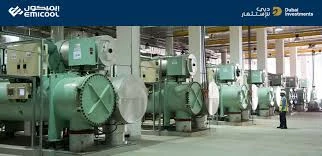
A district cooling energy system is an advanced method of cooling large areas efficiently. Instead of relying on individual air conditioning units in buildings, this system centralises cooling production, distributing chilled water through an insulated pipeline network to multiple structures. This approach not only reduces electricity consumption but also minimises environmental impact, making it an essential solution for sustainable urban development.
District cooling works by using centralised plants equipped with large-scale chillers that generate chilled water. This water is then circulated to various buildings through underground pipes, cooling indoor spaces efficiently before returning to the plant to be re-cooled and reused. This closed-loop process optimises energy consumption while ensuring consistent cooling performance.
The Financial Aspects
Although district cooling offers long-term cost savings, consumers often focus on district cooling charges, which vary based on multiple factors such as location, provider, and infrastructure. Typically, these charges include a fixed capacity fee and a variable consumption fee. The capacity charge covers the cost of maintaining and operating the cooling infrastructure, while the consumption fee depends on the actual usage of chilled water.
In cities like Dubai, where district cooling is widely adopted, authorities regulate pricing to ensure affordability and transparency. However, some consumers express concerns over pricing structures, especially in residential areas. To address this, providers are working towards flexible pricing models and introducing technology-driven solutions to optimise energy efficiency, ultimately lowering costs for end users.
Community and Urban Development Impact
District cooling energy systems offer benefits that go beyond saving energy. They help shape better urban environments and improve the quality of life for residents. With fewer individual cooling units on rooftops, cities enjoy cleaner landscapes and more space for green areas. Urban planners appreciate the reduced visual clutter, which can lead to improved air quality and a more attractive cityscape.
This system also frees up space that can be used for community projects or public parks. A quieter, neater urban setting can boost property values and attract further investment in neighbourhoods. In turn, this supports local businesses and creates jobs in maintenance and customer service. As communities grow, district cooling can be a key part of a sustainable development strategy that brings economic and social benefits.
Why District Cooling Matters for Sustainability
As urbanisation increases, the demand for cooling solutions grows, leading to higher energy consumption and carbon emissions. This is where energy-efficient cooling systems, such as district cooling, play a crucial role. By centralising cooling production, these systems use less electricity compared to conventional air conditioning units, reducing the overall strain on power grids and lowering greenhouse gas emissions.
Additionally, district cooling integrates well with renewable energy sources such as solar power, making it a sustainable choice for modern cities. Governments and developers are recognising the importance of investing in district cooling as part of their long-term sustainability goals. By implementing these systems, cities can achieve significant energy savings, reduce water consumption, and create a more eco-friendly environment for future generations.
Conclusion
District cooling energy systems are transforming the way cities manage cooling needs. By offering a more sustainable and cost-effective alternative to traditional air conditioning, they contribute to energy conservation and environmental protection. As technology continues to evolve, these systems will become even more efficient, making them an essential part of future urban planning.


